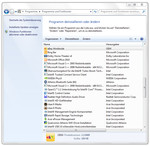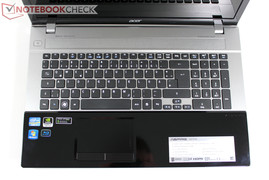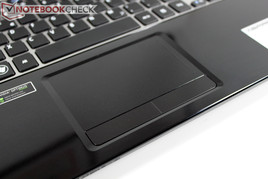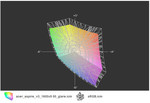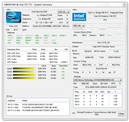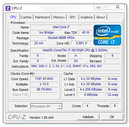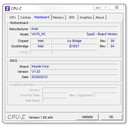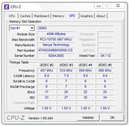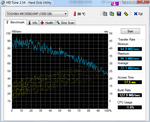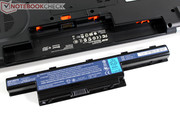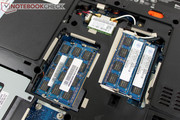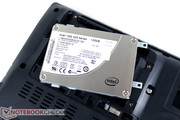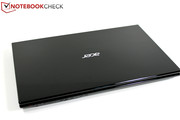Review Acer Aspire V3-771G Notebook
Acer promises timeless elegance and extraordinary computing power with its new Aspire V3 range. On Acer's product page, phrases like "excellent multitasking", "online media consumption" and "intense graphic gaming" are used in the same breath. Well, if that is not a masterpiece of engineering then what is?
Now seriously, Acer aims the V3 at customers focused on performance and hesitantly tries to even bring its mobile products closer to gaming enthusiasts. Until now, Acer did not have any full-blown gaming machines in its range. The V3 range will be a member of Acer's premium performance range.
Acer has built a couple of 15 inch models in the Ethos range (Aspire 5951G) and one 18 inch behemoth (Aspire 8951G) in the past. However the V3-771G featuring a 17.3 inch screen is a new entry with no predecessor. It could, at best, be compared with the multimedia notebook Aspire 7750G, equipped with AMD's potent 6850G graphics.
What does the Aspire V3-771G have inside? Well, as the "G" in the model number already hints at- a good portion of graphics power. To be specific, the Nvidia's GeForce GT 650M GPU provides the graphic processing power for the notebook. It is a chip based on Nvidia's brand new Kepler architecture (28 nm), which is positioned in the upper midrange. Its performance can be compared with the older GTX 460M or the GTX 560M. They were members of the gaming upper range just a year ago.
The GPU is backed by a processor from the latest Intel Ivy Bridge generation. The i7-3610QM chip is virtually the entry into Intel’s lineup of mobile quad-core CPUs. Since the 17 inch case has enough room inside, Acer has provided two 2.5 inch drive slots which are occupied by a 120 GB SSD as the boot drive and a 1 TB data HDD for data storage in our test configuration.
Case
Acer has gone in for a plain glossy finish to the laptop. The Piano paint finish is a throwback to the past which shows scratches and fingerprints very easily. This is a major drawback of the V3. The display lid, screen bezel and the wrist rest gleam at the user – at least, for a while just after taking it out of its packaging. It only takes a few hours of use until fingerprints and dust particles begin to gather. The surface has a sticky feel to it. In the last few months it almost seemed that this kind of surface paint job was finally going out of fashion. Acer has not done enough to disguise the cheap plastic that is used to build the chassis before putting it on sale.
At least the laptop looks nice out of the box. The silver keyboard bezel perks up the otherwise completely black device. If it weren't for the lid's and wrist rest's glossy surfaces, the term "conservative design" could apply to the device.
The plastic case's stability remains beyond reproach. No creaking noises or wobbly components are noticed when handling the device. The big 17 inch screen could be a bit more rigid. However that can be ignored in view of the restricted portability of the form factor.
A look at the street prices explains the choice of the case. The Aspire V3 starts at an incredible EUR 595(~$750). However, this version is still equipped with a Sandy Bridge CPU and GT 640M graphics. Nevertheless, there isn't much room for a higher quality case in view of this competitive pricing.
Connectivity
In our opinion, Acer has done a decent job when it comes to port selection but the placement is not satisfactory. All ports are located on the left and right side edges towards the front. This may provide easy access to the ports, but is less optimal for keeping the work area beside the notebook clear of obstructive and unsightly cables.
We find VGA, HDMI, LAN, 2x USB 3.0 and 2x USB 2.0 as well as a headphone and microphone jack. The home user will be sufficiently equipped but an enthusiast will certainly find reason for complaint. The laptop also comes with a Bluray drive and a card reader ( MMC, SD, MS Pro, xD) is provided at the front.
Communication
LAN (Gigabit) and WLAN (802.11 b/g/n) are provided by an Atheros chip. Bluetooth version 4.0 is also installed in our test device.
Software
You get a lot of preinstalled software when you buy the notebook where most of it is actually unwanted. This software is called bloat. In many cases, the bloatware affects the performance of the laptops. Some manufacturers please the buyer with an agreeably clean system, while others go overboard, installing too much junk. Acer belongs to the latter category even if it does not cause the Aspire V3-771G any performance issues. The solid state drive ensures that the system feels snappy and responsive from the first boot. The desktop comes up in just 10 – 15 seconds after powering on the laptop.
However, you should consider that the system's SSD only has a capacity of 120 GB. The user is restricted to around 100GB after format and about 70GB after the installation of the OS and essential system software. Therefore it is advisable to use the SSD primarily for frequently used software. Other data, such as music, videos and games, should be stored on the 1000 GB mechanical hard disk.
Maintenance
The user can access both hard disk slots, all four RAM slots, the wifi module and a free mSATA slot via a fairly large cover on the device's bottom. However, the CPU and GPU as well as the entire cooling system are not accessible. You risk voiding the warranty if you open up the device beyond that.
Warranty
The warranty specifications found in various shops cause confusion. Upon inquiry, Acer states a warranty period of 2 years (24 months) for all V3-771G configurations including pick-up & return service. You also get a one year International Travelers Warranty.
Input Devices
Keyboard
A chiclet-style keyboard is almost always used when looks matter. The present Acer Aspire V3 is no exception. However, that does not mean that it is not possible to type on such a pretty keyboard. We find a key size of 15 x 15 millimeters with a key gap of approximately 4. The function and arrow keys are smaller. The user can take delight in a dedicated number pad. The familiar functions such as volume control are managed with FN key combinations.
Users won’t have much to complain about the keyboard layout. Deviations are only seen on the ">/<" and "#/'" keys, which are placed directly beside their neighboring key (it is the two-rowed enter key in the latter case). Nevertheless, that should not lead to difficulties when typing after a bit of practice.
What does the typing feel like? Basically, all keys feature a clear pressure point with a medium key drop. The noise level is quiet to audible depending on the stroke. So if you belong to the group of energetic typists, you can "enjoy" the clatter according to the zone of the key you hit.
Touchpad
The installed multi-touchpad is slightly lowered in the case and can easily be located without looking. Its surface is made of the same plastic material as the surroundings. However, it is slightly roughened which greatly contributes to the gliding characteristics.
We had a few minor problems particularly in the first few minutes while trying to familiarize ourselves with the touchpad. Tap-to-click was often not accepted and our fingers frequently strayed into the scroll field at the right edge. Alps' extensive configuration menu however allows many settings for customizing the touchpad to suit personal needs. After disabling the vertical scroll bar, two-finger based scrolling worked much better.
Display
We would have definitely expected a Full HD screen in a powerful 17 inch multimedia notebook or desktop replacement, especially in the fully loaded configuration we tested. This is unfortunately not the case. Acer relies on a HD+ screen with a maximum resolution of 1600 x 900 pixels. This is alright in terms of a desktop replacement for normal users, but disappointing when you have the BluRay option that is best viewed on a 1080p screen. Several competitors consistently use Full HD screens in the same price range. Examples would be Asus' N75SF or the upcoming Asus N76 and the members of HP's Pavilion dv7 range.
The compromise in the screen quality in lieu of keeping the price down is noticeable when it was analyzed. The AUO139E screen has a maximum brightness of 230 cd/m2 in our measurements that drop to an average of 213cd/m2 across all nine quadrants. With a comparatively high black value of 1.26 cd/m2, the maximum possible contrast of 171:1 is pretty average.
| |||||||||||||||||||||||||
Brightness Distribution: 86 %
Center on Battery: 215 cd/m²
Contrast: 171:1 (Black: 1.26 cd/m²)
53.4% AdobeRGB 1998 (Argyll 3D)
77.8% sRGB (Argyll 3D)
51.7% Display P3 (Argyll 3D)
A big-spender should expect higher quality components than what is offered on this laptop. It isn’t just about the power of the CPU and the GPU but the other components of the laptop need to be taken into account when it comes to a good user experience. The screen plays a very important role here as higher productivity can be achieved with larger screen resolutions which allow more tasks to be displayed on screen. It is no surprise that the color spectrum covered by this screen doesn’t match up to the sRGB spectrum. Professionals would likely stay away from this laptop. The glossy screen and the moderate brightness of the screen prevent any usage outdoors. The V3 is a desktop replacement and performs adequately as one.
The horizontal viewing angle stability is good. However, disturbing reflections quickly form if viewed from the sides. Vertical viewing angles are poor and images are prone to fade or undergo color inversion.
Performance
Now we come to the "core competence" of the Acer's Aspire V3-771G – the performance. As mentioned in the beginning, we are dealing with the premium configuration of the V3-771G. The new Intel i7-3610QM quad core CPU from the latest Ivy Bridge line is used in conjunction with an Nvidia GT 650M graphics card equipped with a 2GB DDR3 video memory. Moreover, Acer provides the device with a large 16 GB of working memory. However, the normal user should not really expect any great advantages from it. On the other hand, the combination of a 120 GB Intel SSD with a capacious 1000 GB conventional hard disk pleases us.
Processor: Intel Core i7-3610QM "Ivy Bridge"
The 3610QM CPU is an entry-level quad core from Intel's brand new Ivy Bridge platform. By switching to the 22nm manufacturing process and adding several new features, it can leave many of its famous Sandy Bridge brethren behind. It is one of the fastest processors on the market today.
The chip overclocks automatically from a base clock of 2.3 GHz up to 3.3 GHz in Turbo mode, depending on the required performance and available cooling. The clock drops to 1200 MHz when performance is not needed. The CPU can process up to eight threads at the same time using Hyper Threading. Details about the CPU can be found in our processor database.
An extensive comparison of the new Intel Ivy Bridge quad core processors can also be found here on Notebookcheck.
The CPU was benchmarked using Cinebench R11.5. The results are around the expected level with 6.19 points in the CPU benchmark. MSI's GT70 with the same CPU scores a bit better herewith a score of 6.26 points. The minor difference is found in the variable Turbo that lets Acer's Aspire reach 3.1 GHz in Cinebench R11's CPU test.
A comparison with the Sandy Bridge range is impressive: Intel's absolute premium i7-2920XM CPU up until a few weeks ago was only slightly superior to the new 3610QM. The Sandy Bridge CPU reached 6.20 points in Dell's Precision M6600.
Graphics Card: Nvidia Geforce GT 650M 2 GB DDR3
A sticker on the device indicates the implementation of Nvidia's Optimus. This means that there is automatic switching between the dedicated graphics and the IGP depending on the usage pattern observed by the Optimus software. A small icon in the task bar shows which GPU is enabled. An application can be forced to start with one of the two graphics solutions (tray icon: "Fade in options in context menu", program start via right click "Run with graphics processor"). The user can then open all options like a modern, sophisticated automatic gear unit.
A brief look at both graphics chip in detail: Intel's HD Graphics 4000 is the successor of the HD 3000 solution integrated in Sandy Bridge CPUs. Unlike the earlier revisions of the IGP, the HD 4000 now offers the performance capacities of a dedicated midrange graphics solution. It can handle most routine tasks and some games easily. You can find an in-depth performance check of the HD Graphics 4000 in our special article.
So why an additional dedicated graphics card? This question is justified depending on the intended use. The system will first enable the installed Nvidia GeForce GT 650M for complex calculations or elaborate 3D graphics. A very significant field is computer games and Acer definitely wants to address these fans with its Acer Aspire V3 range.
Like the CPU, the GT 650M is a brand new chip. The GT 650M is based on the Kepler architecture and is manufactured using the 28nm process. The video memory is either the DDR3 or the faster GDDR5 version depending on the configuration. In case of the present V3, the less expensive DDR3 memory is used (2 GB, VRAM) and thus the GT 650M's potential gaming prowess is not observed in this case. We will therefore also examine One's M73-2O that integrates the GT 650M with the faster GDDR5 for comparison.
The Aspire V3 scores well in the first 3DMark benchmarks. A score of 12845 in 3DMark 2006 is at the level of premium gaming machines such as the MSI's GT 663R and the Asus' G53JW, both of which are equipped with the GTX 460M.
3DMark 2011 virtually shows the same. Here, the Aspire V3 finishes with a score of 1628. The GTX 560M in Toshiba's Qosmio X770 with 1724 seems to be within reach.
Comparing it to the GT 650M version with GDDR5 in the One's M73-2O (with a 3720QM CPU) which achieved a solid 1802 points in the same benchmark tests. That is a performance increase of approximately 11%. When only looking at the GPU sub-score, which excludes the slightly better CPU in the comparison device, the advantage is considerably lower at only 4%.
| 3DMark 06 Standard Score | 12845 points | |
| 3DMark Vantage P Result | 8357 points | |
| 3DMark 11 Performance | 2143 points | |
Help | ||
Mass Storage
Slowly but surely, solid state drives are becoming affordable. Responsible for this is the falling prices for memory chips as well as new technologies which allow process shrinks that enable more memory to be placed on a single board. The mSATA standard has also allowed users to experience the speed of a standalone SSD without sacrificing the single HDD in many smaller laptops. This normally means the speed of an SSD in OS related tasks as well as some important applications placed on the mSATA drive and the added storage using the cheaper mechanical HDD. SSDs are still expensive today as higher capacity ones normally cost an arm and a leg in comparison to conventional hard drives.
Acer's Aspire V3 pursues this strategy in our premium configuration. However, it is possible to use a conventional SSD due to the two existing 2.5 inch drive bays.
The installed Intel Series 320 SSD (SSDSA2CW120G3) has a capacity of 120 GB and its standalone version is around EUR 150(~ $190) at many retailers. The drive manages a read and write speed of up to 230MB/sand 130 MB/s respectively in the CrystalDiskMark benchmark. This SSD is from the last generation and is limited to these speeds as it is using the SATA II controller that limits its performance. It has been replaced by the new Intel 330 line of SSDs that feature a heavily tweaked Sandforce controller. Although other SSDs easily surpass the installed Intel drive, the comparison with the Toshiba MK1059GSMP hard disk in the Aspire V3-771G is impressive: Access speed: 17.5 milliseconds vs. 0.18 / 0.12 for the Intel SSD.
This results in a fast system boot up of about 10 seconds. Applications and files installed on the SSD open in a flash giving the impression of instantaneous response to input which makes the user experience that much better.
System Performance
The latest PCMark 7 is one possibility to compare the system's overall performance. It processes a mix of standardized applications and tasks. Acer's Aspire V3 places itself in the top portion of our database with a total score of 4160 points. Only few gaming machines managed to turn in a better score. One reason for this is the new Ivy Bridge CPU. However, the implemented SSD-HDD array also contributes a major part. For example, MSI's GT780DX gaming notebook with a 2670QM CPU and GTX 570M GPU is found on a very similar level.
This result lets us conclude that the Acer Aspire V3-771G configuration is perfectly equipped for virtually every conceivable application scenario. The system can even cope with complex picture and video editing, subject to driver support and the user necessity.
| PCMark Vantage Result | 14757 points | |
| PCMark 7 Score | 4160 points | |
Help | ||
Gaming Performance
Since Acer particularly wants to attract the attention of gamers, we tested the laptop for gaming performance. The notebook has to show how well it deals with a few up-to-date games if it can be put on the lists of potential buyers looking at this specific purpose.
We start with Anno 2070 (demo). We recorded an average frame rate of 36.9 fps in our benchmarking sequence using our standard settings for high graphic details (1366 x 768, AA, 2x AF). This result places the Aspire V3 just behind the Medion's Erazer X7813 with the GTX 560M graphics. Older cards like the GT 555M in Schenker's A501 (25.7 fps) clearly lag behind. The GDDR5 version in One's M73-2O is on a par with 36.2 fps.
| Anno 2070 - 1366x768 High Preset AA:on AF:2x (sort by value) | |
| Acer Aspire V3-771G | |
| One M73-2O | |
| Schenker XMG A501 | |
| Medion Erazer X7813-MD97895 | |
| Acer Aspire M3-581TG | |
We continue with the very popular FPS that taxes modern hardware- Battlefield 3. In high graphic presets (1366 x 768, high, 16x AF), we reach 31.1 fps in our benchmark. One's M73 GDDR5 configuration manages a slightly better 34.1 fps. Again, Nvidia's GT 650M places itself between the older GT 555M / the new GT 640M (Acer Aspire M3) and the GTX 560M high-end graphics of the previous generation (Toshiba Qosmio X770).
| Battlefield 3 - 1366x768 high AA:- AF:16x (sort by value) | |
| Acer Aspire V3-771G | |
| One M73-2O | |
| Acer Aspire M3-581TG | |
| Toshiba Qosmio X775-Q7272 | |
| Asus N75SF | |
Fifa 12 is no problem even at maximum details and using an external monitor (1920 x 1080, high, 4x AA). With 124 frames per second, there is more than enough room for the more demanding cut scenes. In comparison, the GDDR5 in One's M73 accomplished 145 fps, but with a stronger 3720QM CPU.
The last game in this lineup is the demo version of Mass Effect 3. We also selected maximum details (1920 x 1080) and achieved 35.3 fps in our benchmark. The Aspire M3 with a GT 640M lags behind marginally (32 fps). Nvidia's GTX 560M in the XMG P501 gains a lot of ground with 44 fps. Our One M73's GDDR5 version reaches 49.5 fps well ahead of the pack.
In conclusion, we can say that Acer's gaming project is a success. Although the resolution and details level have to often be reduced, the available performance is enough for smooth game play and stunning graphics. The GT 650M places itself between the mid and upper range of mobile graphics cards and is definitely an interesting choice for casual gamers. The DDR3 VRAM based card is weaker in performance compared to the GDDR5 version but not by much. Frame rates drop at higher resolutions faster than with the GDDR5 version.
| low | med. | high | ultra | |
|---|---|---|---|---|
| Fifa 12 (2011) | 390 | 246.9 | 187.5 | 123.7 |
| Battlefield 3 (2011) | 57.9 | 39.61 | 31.14 | 11.76 |
| Anno 2070 (2011) | 142.2 | 62.5 | 36.85 | 18.83 |
| Mass Effect 3 (2012) | 60 | 56.6 | 35.26 |
Emissions
System Noise
Although Acer's Aspire V3-771G has quite a bit to offer in terms of performance, the device stays pleasantly quiet in routine use. We even observed that the fan shuts down completely for a short period. The noise during office use without load settles a low 32.9 dB (A). Only a quiet hum is audible from the notebook. The fan speed increases during load, e.g. computer games, and reaches a level of 39.8 dB (A) which is still acceptable. A maximum of 44.6 dB (A) is first reached in the unrealistic stress test, like when the CPU and GPU are full load for over an hour.
Noise level
| Idle |
| 28.2 / 32.9 / 36.4 dB(A) |
| HDD |
| 32.9 dB(A) |
| DVD |
| 36.4 / dB(A) |
| Load |
| 39.8 / 44.6 dB(A) |
 | ||
30 dB silent 40 dB(A) audible 50 dB(A) loud |
||
min: | ||
Temperature
Without load, Acer's Aspire V3's case stays extremely cool. We measured a maximum of just below 28°C on the surface at a room temperature of 22.5°C. The surface temperatures increase after an hour of stress testing and reach approximately 44°C on both top and bottom surfaces of the case.
Measurements of the components during the stress test show a hot CPU. The core temperature quickly reaches 100°C according to HWInfo. Consequently, the CPU throttles to 1.2 GHz. When the temperatures drop, the chip increases its clock frequency again.
We performed 3DMark 2006 benchmark directly after the stress test to see if this had an impact during normal usage. The result does not differ much compared with the cold state. Thus, thermal throttling should not be an issue under normal usage and during gaming.
(±) The maximum temperature on the upper side is 43.9 °C / 111 F, compared to the average of 36.9 °C / 98 F, ranging from 21.1 to 71 °C for the class Multimedia.
(±) The bottom heats up to a maximum of 43.4 °C / 110 F, compared to the average of 39.2 °C / 103 F
(+) In idle usage, the average temperature for the upper side is 26.3 °C / 79 F, compared to the device average of 31.3 °C / 88 F.
(+) The palmrests and touchpad are reaching skin temperature as a maximum (35.6 °C / 96.1 F) and are therefore not hot.
(-) The average temperature of the palmrest area of similar devices was 28.7 °C / 83.7 F (-6.9 °C / -12.4 F).
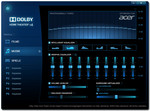
Speakers
We read "Dolby Home Theater" and "Professionally Tuned" above the perforated cover that undoubtedly hides the speakers. Those tags sound good even if installing a brand name stereo system was obviously too expensive.
Our verdict on sound ranges from satisfactory to not dynamic enough. The sound quality is acceptable for an inexpensive multimedia machine. However, in our opinion, bass is not full enough to give you a premium experience. In any case, you should make sure that the Dolby Equalizer software is enabled. It improves the sound noticeably.
Battery Life
Power Consumption
The meter records a consumption of 10.1 to 16.9 watts when the Aspire V3's at idle (no load). That is absolutely acceptable in view of the excellent performance that the device demonstrated earlier. Both Intel's Ivy Bridge CPU and Nvidia's Optimus work together perfectly and cut the power consumption to the bare minimum.
But when under load,we measured a maximum of 112.5 watts in the extreme case induced by the stress test, which loads both the CPU and GPU to the maximum. The included 120 watt power adapter should be able to cope with that.
| Off / Standby | |
| Idle | |
| Load |
|
Key:
min: | |
Battery Runtime
Battery Runtime
In view of the available power capacities, we do not expect surprises from the 48 watt battery. In the best case (minimum screen brightness, wireless modules off, energy savings mode), the battery lasts a decent 280 minutesor more than 4.5 hours in the Reader's test.
On the other hand, the runtime in wifi mode is more relevant for practical use. A script where defined websites are visited with adjusted brightness (approx. 150 cd/m2) is used here. We recorded 163 minutes which is only about 2.5 hours.
When the notebook at load (BatteryEater Classic test), you will have to reckon with only about an hour of battery power.
Verdict
You need to pay particular attention to the price when buying the Acer Aspire V3-771G. There are great differences between the inexpensive entry-level configuration and the ‘premium devices’ like our test sample. Looking at the current street prices, it ranges between EUR 595(~$750) to EUR 1299(~$1650). The differences are dependent on the installed CPU, GPU, mass storage, RAM and optical drive. However, the case is an invariable factor, and so the EUR 1299 high-end version is in the same plastic case with the same mainstream screen as the entry-level version.
That brings us straight to the Acer Aspire V3's qualities. The case is acceptable for the price of below EUR 1000. We have problems accepting the case's high-gloss parts for many reasons. But that is also partly a matter of taste. The connectivity is satisfactory, unlike the ports positioning at the far front side edges.
The chiclet keyboard is pleasing. The touchpad could do with a bit of driver tuning, but it basically works. We would have expected higher quality equipment in the more expensive configurations. That particularly applies to the screen. A HD+ resolution with an average brightness of approx. 200 cd/m2 and a weak contrast of only 171:1 isn't very attractive in a price range of over EUR 1000. However, it is acceptable for the lower priced alternatives.
Acer's Aspire V3 premium model could show us its performance potential. And it was impressive. Intel's Ivy Bridge quad core CPU and Nvidia's GT 650M Kepler graphics card result in a first-rate multimedia experience and that is backed with impressive benchmark results in our tests. Not the least, the SSD installed in the premium configuration contributes a significant part to the package.
You should not have high expectations on mobility. The poor battery life of 2 – 3 hours and the reflective screen confine the device to the desk.
Choosing the right Aspire V3 model from the range depends on what you expect from the device. If you require high application performance, personal picture and video editing, we would recommend the premium model with the SSD. However, an aftermarket SSD would be a cheaper option depending on the configuration you are looking at.
Computer gamers should take the model equipped with the powerful dedicated GT 650M. If you are simply looking for an affordable multimedia machine for no specific application field, the cheapest models will likely be particularly interesting. However, either the "old" Sandy Bridge processors (and they still do a good job) which are available right now or the new Ivy Bridge dual core processors which won’t be released for a few more weeks.








